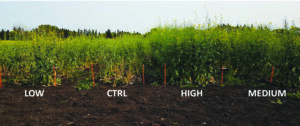Hydrated lime treatments reduce clubroot infection
KEY RESULT:
A study of integrated management practices to manage clubroot show a benefit from hydrated lime treatments, particularly for clubroot-susceptible cultivars.
PROJECT TITLE, PRINCIPAL INVESTIGATORS:
“Canadian Canola Clubroot Cluster (C1) Pillar 1: Integrated Disease Management,” Sheau-Fang Hwang and Stephen Strelkov, University of Alberta
FUNDING:
AgriScience Program (Canola Cluster) under the Canadian Agricultural Partnership
PUBLISHED ARTICLES:
Read the full report on the Canola Research Hub.
The utility of genetic resistance as a clubroot management tool is at risk. The entire zone infested by clubroot is susceptible to resistance breakdown and every commercially available clubroot-resistant genotype of canola is potentially susceptible to novel clubroot strains. Deployment of resistant canola varieties must be combined with other clubroot management strategies.
This project explored various strategies, including lime, canola cultivar rotation and perennial grasses.
Hydrated lime (not limestone) can work
Researchers conducted field and greenhouse trials to study the effects of lime amendments to soil. For the field trials (at the Crop Diversification Centre North, Edmonton), researchers spread three rates of hydrated lime and seeded a susceptible canola cultivar. Rates were low (4.7 tonnes per hectare or 1.9 tonnes per acre), medium (8.0 t/ha) and high (11.4 t/ha).
At the first field site, untreated control blocks had a pH of 5.6. The highest lime treatment increased pH to 7.8 at the time of seeding. This high rate reduced the clubroot disease severity index by 91 per cent at eight weeks after planting and by 71 per cent at harvest time. The high rate increased yield by 13 per cent. At the second field site, untreated control blocks had a pH of 5.5. The highest lime rate increased soil to a pH of 7.7 at the time of seeding. The high rate reduced the clubroot disease severity index by 45 per cent at eight weeks after planting and 50 per cent at harvest time. Yield increased 343 per cent.
For greenhouse trials, researchers inoculated potting soil with four different populations of P. brassicae spores, then treated the soil with “zero grind” limestone or hydrated lime at rates equivalent to 4.7, 8.1, 11.4 and 14.8 t/ha of lime. These rates adjusted the pH to 6.0, 6.5, 7.0 and 7.5, respectively. Eight weeks after inoculation, disease severity indices were 92-100 per cent and nine-13 per cent, respectively, in the susceptible and resistant controls (no lime) treatments. The index of disease decreased to zero per cent in both the susceptible and resistant cultivars following treatment with any of four tested rates of hydrated lime. In contrast, the application of limestone resulted in a modest decrease in clubroot severity and only at the two lowest inoculum levels evaluated.
Researchers also note that when clubroot resistance worked on the clubroot pathotypes present in a field, lime didn’t help yield.
Cultivar rotation
Researchers used a greenhouse study to compare continuous cropping of three treatments: the same susceptible canola cultivar, the same resistant canola cultivar and alternating resistant canola cultivars.
At the end of the first cycle of each rotation, the susceptible cultivar had a disease severity index of highest 91.5 per cent, the resistant cultivar had an index of 78.0 and the resistant rotation had an index of 69.1. Back to back canola increases the risk of clubroot, and CR only helps marginally and for only a short time. After subsequent rotation cycles, disease levels were not significantly different.
Wheat a good rotation crop
Researchers conducted growth room studies to assess the effect of dense seedlings of perennial grasses and conventional rotation crops (wheat, barley, pea and soybean) on resting spores of P. brassicae. They showed that resting spore concentration declined more quickly in the presence of grass and wheat seedlings than in bare soil. Wheat was as good at reducing spores in soil as perennial ryegrass, but the effect of barley was less consistent, and soybean did not result in any measurable reduction relative to bare soil.






